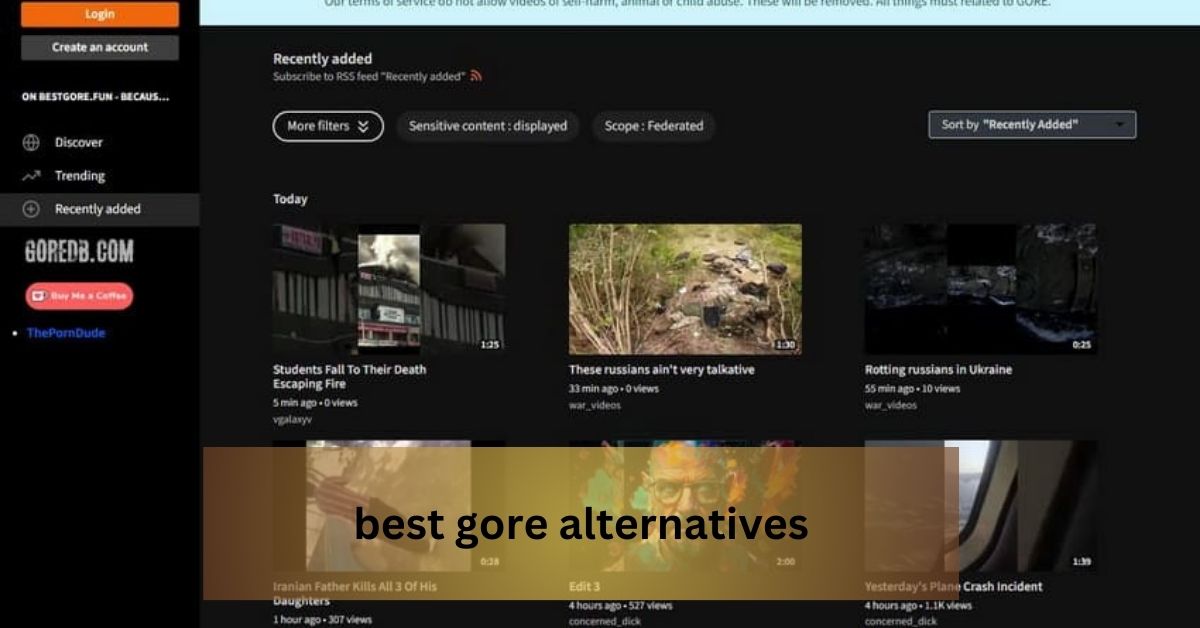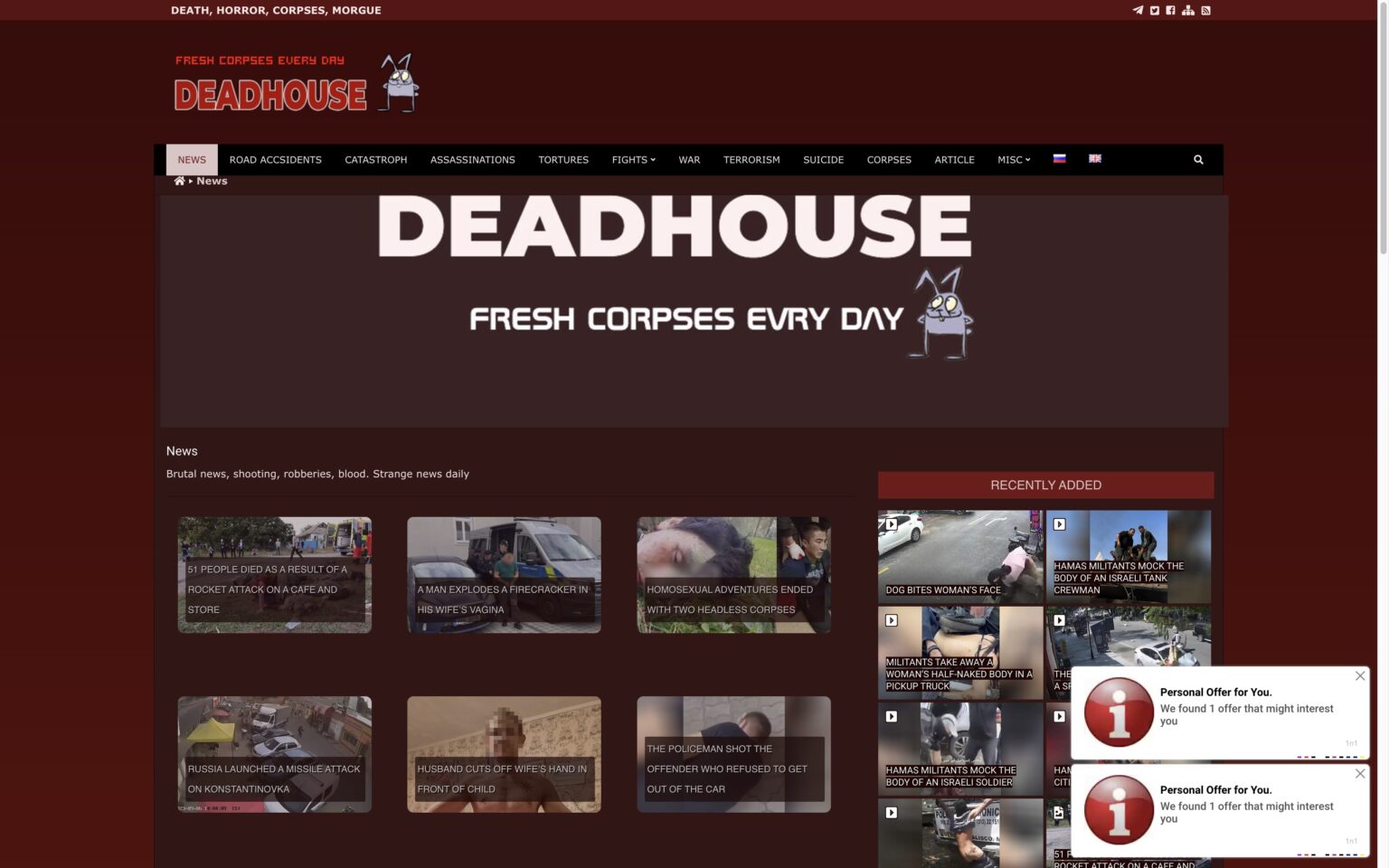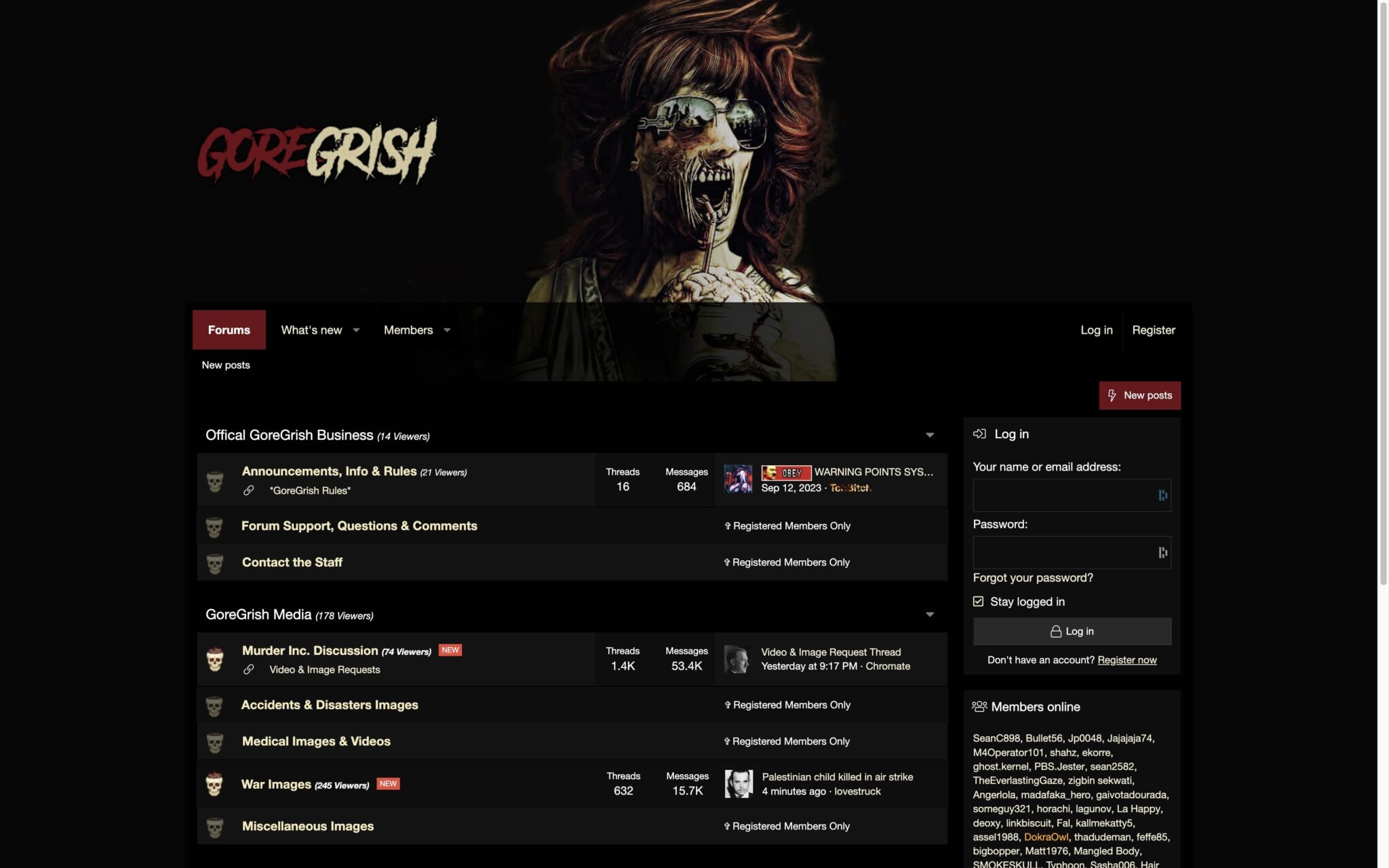Best Bestgore Alternatives? Shock Sites & Morbid Reality Explored
In a world increasingly sanitized and curated, do we still harbor a morbid curiosity about the darker aspects of reality? The enduring fascination with shock sites, those digital repositories of the gruesome and unsettling, suggests that, for some, the answer is a resounding yes.
The now-defunct Bestgore, a Canadian shock site, serves as a focal point for this exploration. Once a haven for those seeking uncensored depictions of death, violence, and the macabre, its closure has left a void in the online landscape. Its owner, Mark Marek, is reportedly seeking a seven-figure sum for the domain, a testament to the site's former notoriety. The quest to find suitable alternatives continues, highlighting a persistent demand for this type of content, despite its controversial nature.
| Attribute | Details |
|---|---|
| Site Name | Bestgore (defunct) |
| Type | Shock Site |
| Content | Gore, violence, depictions of death, macabre content |
| Location | Canada |
| Status | Shutdown |
| Owner | Mark Marek |
| Domain Price | Reportedly being sold for a 7-figure price tag |
| Community Size | N/A |
| Ethical Concerns | Racism, desensitization, exploitation |
| Alternatives | Kaotic, Liveleak (archived), Documenting Reality, YNC, RunTheGauntlet, Goregrish, Rotten, Shockgore, CrazyShit, SeeGore, Bestgore.fun, Veoh, Alivegore |
| Reference | Wikipedia - BestGore |
The search for alternatives to Bestgore isn't simply about replacing a website; it's about finding platforms that, for some, fulfill a specific need. This need might stem from a genuine interest in true crime, a fascination with the macabre, or a desire to confront the harsh realities of the world, however unpleasant they may be. However, many users expressed a need to avoid the racism and hateful speech that was sometimes prevalent on Bestgore, suggesting a desire for a space where disturbing content could be viewed without the added layer of social toxicity.
Several sites have been mentioned as potential alternatives, each with its own characteristics and limitations. Kaotic is noted as being among the most active. Liveleak, although shut down, has much of its content archived via the Wayback Machine. Documenting Reality is still functioning, but is considered somewhat outdated. YNC operates behind a paywall, requiring a subscription for access. RunTheGauntlet is characterized by its abundance of particularly disturbing content, while Goregrish is described as having an old-school forum layout that can be difficult to navigate. Rotten and Shockgore are also listed as outdated and shut down, respectively. CrazyShit, on the other hand, is noted as primarily featuring pornography, and SeeGore is also considered outdated.
The challenge in finding a direct replacement for Bestgore lies in the unique combination of factors that contributed to its popularity and infamy. It was a central hub, a gathering place for a specific online community. It also offered a level of uncensored content that's increasingly rare on the modern internet. While many sites offer graphic material, few achieve the same level of notoriety or attract the same kind of audience as Bestgore did in its prime.
One user, identifying as a Black woman with an interest in true crime and the macabre, highlighted the complex relationship many had with Bestgore. While acknowledging the site's comprehensive nature, she also noted the presence of "vile racism," which ultimately led her to seek out other platforms. This speaks to a broader concern about the ethical implications of hosting and consuming such content. The line between documenting reality and exploiting tragedy can be a blurry one, and the potential for these sites to become breeding grounds for hateful ideologies is a legitimate concern.
The Reddit communities r/death and r/morbidreality are mentioned as possible alternatives. With 48,000 and 1 million subscribers respectively, these subreddits offer spaces for discussion and the sharing of disturbing content, though within the confines of Reddit's content policies. The very descriptions of these communities"where death and dying are open for discussion" and "a subreddit devoted to the most disturbing content"underscore the specific niche they fill. They provide a forum for individuals to explore their morbid curiosity in a (relatively) controlled environment.
The question of whether these sites are "good" is, of course, subjective and fraught with ethical considerations. What constitutes "good" for one person may be deeply offensive or harmful to another. The fact that these sites often require age verification (explicitly intended for adults over 18) underscores the mature nature of the material and the potential for psychological distress.
The user-generated content found on many of these sites also raises questions about authenticity and context. Without proper verification, it can be difficult to determine the origin or accuracy of the images and videos being shared. This can lead to the spread of misinformation and the potential for the exploitation of victims. The lack of moderation on some platforms can also create an environment where harmful ideologies can thrive, as highlighted by the user's experience with racism on Bestgore.
Alternatives mentioned include Bestgore.fun, described as unorganized but containing gore, and Veoh, which offers a wide selection of videos across various categories. Veoh is presented as a less visually intense option, while Alivegore is suggested as a place to stream extreme videos. These alternatives represent a range of options, from direct replacements to platforms offering similar, but perhaps less graphic, content. The key difference between these sites and Bestgore often lies in the level of moderation and the overall community atmosphere.
The closure of Bestgore and the subsequent search for alternatives highlight a complex and often uncomfortable aspect of human curiosity. While the desire to confront the darker aspects of reality may be a natural one, it's crucial to do so in a responsible and ethical manner. The potential for harmboth to individuals and to society as a wholeshould not be ignored. The rise and fall of Bestgore serves as a cautionary tale, reminding us of the fine line between documenting reality and exploiting tragedy.
Moreover, the persistent demand for such content prompts a broader discussion about desensitization and its potential effects. Repeated exposure to graphic violence can, over time, diminish emotional responses and potentially lead to a distorted perception of reality. While some argue that such exposure can serve as a form of catharsis or a way to confront one's fears, others worry about the long-term psychological consequences.
The legal and ethical considerations surrounding these sites are also significant. The legality of hosting and distributing graphic content varies depending on jurisdiction. Issues such as copyright infringement, privacy violations, and the potential for inciting violence are all relevant concerns. The operators of these sites often face a difficult balancing act between providing a platform for free expression and ensuring that their content does not violate the law or contribute to harm.
In conclusion, the story of Bestgore and its alternatives is a reflection of our complex relationship with death, violence, and the macabre. It raises important questions about the nature of curiosity, the ethical responsibilities of online platforms, and the potential consequences of consuming graphic content. As the internet continues to evolve, it's crucial to engage in open and honest conversations about these issues, so we can navigate the digital landscape in a responsible and ethical manner. The absence of Bestgore doesn't mean the end of this type of content; it simply shifts the landscape, requiring users to be more discerning and aware of the potential pitfalls.
The quest for alternative platforms is also influenced by evolving societal norms and standards regarding online content. What was once considered acceptable may now be deemed offensive or harmful, reflecting a growing awareness of the potential for online content to contribute to real-world harm. This shift has led to increased pressure on social media platforms and websites to moderate their content more effectively and to take action against hate speech, misinformation, and other forms of harmful content.
Furthermore, the rise of social media has created new avenues for sharing and consuming graphic content. Images and videos of violence, accidents, and other disturbing events can now be easily disseminated through social media platforms, often without warning or context. This can lead to widespread exposure to traumatic content and potentially contribute to vicarious traumatization. The responsibility for regulating this content falls not only on the platforms themselves but also on individual users, who must be mindful of the potential impact of sharing and viewing such material.
The economic aspects of shock sites are also worth considering. While some sites operate on a non-profit basis, others generate revenue through advertising, subscriptions, or the sale of merchandise. The potential for financial gain can incentivize the creation and distribution of graphic content, even if it is ethically questionable or legally problematic. This creates a conflict of interest, as the desire to maximize profits can outweigh the need to protect users from harm.
The motivations behind seeking out and consuming graphic content are varied and complex. Some individuals may be driven by a desire to confront their fears or to understand the realities of violence and death. Others may be seeking a sense of excitement or arousal. Still, others may be motivated by a morbid curiosity or a desire to shock and disturb others. Understanding these motivations is crucial for developing effective strategies for preventing harm and promoting responsible online behavior.
The psychological impact of viewing graphic content can vary depending on individual factors such as personality, prior experiences, and coping mechanisms. Some individuals may be able to view such content without experiencing any significant negative effects. Others may experience anxiety, depression, nightmares, or other psychological distress. It is important to be aware of these potential risks and to seek help if you are struggling to cope with the psychological impact of viewing graphic content.
The role of education in promoting responsible online behavior is also critical. By educating young people about the potential risks of viewing graphic content and teaching them how to navigate the digital landscape safely, we can help them to make informed decisions and to protect themselves from harm. Education should also focus on developing critical thinking skills, so individuals can evaluate the credibility and context of online content and avoid being misled by misinformation or propaganda.
The future of shock sites remains uncertain. As technology continues to evolve and societal norms continue to shift, these platforms will likely face increasing scrutiny and regulation. However, the underlying demand for graphic content is unlikely to disappear entirely. The challenge will be to find ways to balance the right to free expression with the need to protect individuals from harm and to promote responsible online behavior.
The exploration of Bestgore alternatives also leads to a consideration of the broader phenomenon of "dark tourism," which involves traveling to places associated with death, suffering, or tragedy. Sites like Chernobyl, Auschwitz, and Ground Zero attract visitors who seek to confront the darker aspects of human history and to gain a deeper understanding of the events that occurred there. This phenomenon shares some similarities with the interest in shock sites, as both involve a desire to engage with potentially disturbing or upsetting content. However, dark tourism typically involves a physical journey to a specific location, while shock sites provide access to graphic content from anywhere in the world.
The ethical considerations surrounding dark tourism are also complex. Critics argue that it can be exploitative and disrespectful to the victims of tragedy. They raise concerns about the commodification of suffering and the potential for insensitive or inappropriate behavior. Proponents, on the other hand, argue that dark tourism can serve as a powerful educational tool, helping to preserve the memory of past events and to promote empathy and understanding.
Another related concept is that of "disaster voyeurism," which refers to the tendency to consume news and media related to natural disasters, terrorist attacks, and other tragic events. This phenomenon is often driven by a combination of factors, including a desire to stay informed, a need to process one's own emotions, and a morbid curiosity. Disaster voyeurism can be particularly problematic when it leads to the exploitation of victims or the spread of misinformation. It's important to approach news and media coverage of disasters with a critical eye and to be mindful of the potential for vicarious traumatization.
The discussion of Bestgore and its alternatives also highlights the importance of media literacy in the digital age. With the proliferation of online content, it's crucial to be able to critically evaluate the information we encounter and to distinguish between credible sources and unreliable ones. This includes being aware of the potential for bias, propaganda, and misinformation, as well as understanding the techniques used to manipulate emotions and influence opinions. Media literacy is not just about being able to identify fake news; it's about developing the skills and knowledge necessary to navigate the complex and often overwhelming world of online information.
Finally, it's important to acknowledge the potential for online communities to provide support and connection for individuals who are struggling with difficult emotions or experiences. Online forums and support groups can offer a safe space for people to share their stories, connect with others who understand what they're going through, and access resources and information. However, it's also crucial to be aware of the potential risks of online communities, such as the spread of misinformation, the potential for exploitation, and the lack of face-to-face interaction. It's important to choose online communities carefully and to be mindful of the boundaries between online and offline relationships.
The legacy of Bestgore serves as a reminder of the complex and often contradictory nature of human curiosity. While the desire to explore the darker aspects of reality may be a natural one, it's crucial to do so in a responsible and ethical manner. The potential for harmboth to individuals and to society as a wholeshould not be ignored. As we navigate the ever-evolving digital landscape, it's essential to engage in open and honest conversations about these issues, so we can create a more informed, compassionate, and responsible online world.
The exploration into the alternatives for Bestgore also opens up questions regarding censorship and freedom of speech online. Where do we draw the line between protecting vulnerable individuals from potentially harmful content and upholding the right to express oneself freely? This debate is particularly relevant in the context of shock sites, which often push the boundaries of what is considered acceptable. Some argue that these sites should be shut down entirely, as they contribute to the desensitization of violence and promote harmful ideologies. Others contend that censorship is a slippery slope and that individuals should have the right to access and consume whatever content they choose, as long as it does not directly incite violence or harm.
The rise of decentralized platforms and blockchain technology further complicates the issue of censorship. These technologies make it more difficult for governments and corporations to control the flow of information online. It remains to be seen how these technologies will shape the future of shock sites and other forms of controversial content. One possibility is that they will lead to the proliferation of unregulated platforms where anything goes. Another possibility is that they will empower individuals to create their own curated content feeds, filtering out content that they find offensive or harmful.
The phenomenon of shock sites also raises questions about the role of empathy and compassion in the digital age. In an era where we are constantly bombarded with images of suffering and violence, it can be easy to become desensitized and to lose sight of the human cost of these events. It is important to cultivate empathy and compassion and to remember that behind every image of suffering is a real person with real feelings. This requires making a conscious effort to connect with others, to listen to their stories, and to understand their perspectives. It also means being mindful of the language we use and the images we share online, avoiding language that dehumanizes or trivializes suffering.
Ultimately, the question of how to deal with shock sites and other forms of disturbing content online is a complex one with no easy answers. It requires a multifaceted approach that takes into account the values of free speech, the need to protect vulnerable individuals, and the importance of cultivating empathy and compassion. It also requires ongoing dialogue and collaboration between stakeholders, including governments, corporations, civil society organizations, and individual users.



Detail Author:
- Name : Jordan Rolfson PhD
- Username : morissette.carlos
- Email : hkulas@hotmail.com
- Birthdate : 1988-11-29
- Address : 722 Noemi Mission Apt. 208 Creminview, ID 25983-2220
- Phone : 610-826-9941
- Company : Konopelski Inc
- Job : Millwright
- Bio : Odit quod dolor facere occaecati ut nihil ut vel. Nobis in in adipisci qui. Dolore consequatur quia et quia pariatur. Vel ex error quia et.
Socials
twitter:
- url : https://twitter.com/chad_real
- username : chad_real
- bio : Tempora ipsa minus necessitatibus sit quis. Doloribus aut doloremque maiores magnam nihil. Esse quia nulla nesciunt. Quae mollitia aut laboriosam et dolor.
- followers : 6593
- following : 1684
linkedin:
- url : https://linkedin.com/in/robelc
- username : robelc
- bio : Ut modi quis vel.
- followers : 4480
- following : 231
facebook:
- url : https://facebook.com/robelc
- username : robelc
- bio : Aut aut dolor et omnis dignissimos ducimus.
- followers : 2857
- following : 947
tiktok:
- url : https://tiktok.com/@chad.robel
- username : chad.robel
- bio : Numquam quo repellat mollitia aliquid fugiat.
- followers : 4134
- following : 2826
instagram:
- url : https://instagram.com/chad_id
- username : chad_id
- bio : Sit sunt nulla tenetur harum. Quam odit aut sit sunt.
- followers : 6960
- following : 108